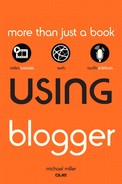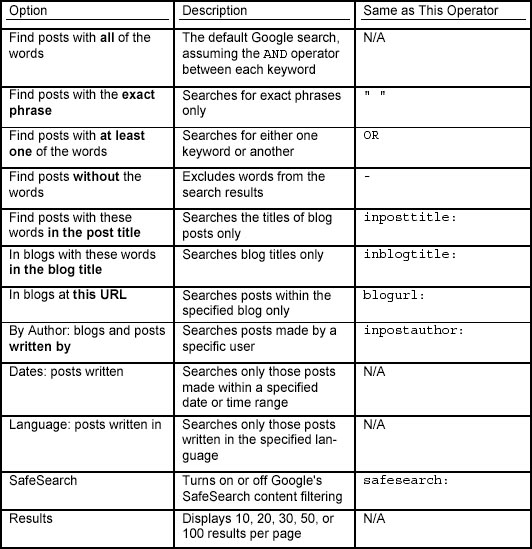2. Visiting Blogger Blogs
Objective: To read and subscribe to Blogger blogs.
You can spend a lot of time reading blogs on the Web. Myself, I read several blogs every day. These include the personal blogs from friends and family; a few blogs that cover local news and events; a variety of tech blogs, such as Engadget and Gizmodo, that keep me up to date on what’s happening in the industry; Politico, the Daily Kos, and a few other political blogs; and a handful of official and unofficial blogs about Google and its various sites and services.
While these blogs all have their own unique content, they also have many features in common. Reading a blog requires nothing more than a quick knowledge of how blogs work and are organized—which is what we cover in this chapter.
Searching for Blogs with Google Blog Search
Before you can read a blog, you first have to find it. As you’ve learned, the Web has literally hundreds of thousands of blogs, covering just about any topic you can think of. But with all these blogs out there, how do you find the ones that are of particular interest to you?
Tell Me More: Media 2.1—How to Find Blogs on the Web

Want to learn more about how to find blogs you might like? Listen to the audio file titled “How to Find Blogs on the Web” on the companion Using website, my.safaribooksonline.com/9780132119603/media.
Just as you use Google to search for web pages, you can also use Google—or, more specifically, Google Blog Search—to search for blogs and blog posts. Google Blog Search is a specialized subset of the main Google search engine, fine-tuned to search the far-reaching blogosphere. Read on to learn more.
How Google Blog Search Works
Here’s one of the problems with the blogosphere—it’s not very organized. You see, there’s no single directory of blog sites, nor of the frequently updated content of all the blogs that exist today. The blogosphere is quite chaotic, and constantly changing; before Google Blog Search, there really wasn’t a good way to find or catalog all the blogs out there.
What Google Blog Search does is track blog content not by using spider or crawler software, which is too slow for the constant flow of blog posts, but rather by tracking site feeds. A site feed is an automatically updated stream of a blog’s contents, enabled by a special XML file format called RSS (Really Simple Syndication). When a blog has an RSS feed enabled, any updated content is automatically published as a special XML file that contains the RSS feed. The syndicated feed is then normally picked up by RSS feed reader programs and RSS aggregators for websites.
Google hit upon the idea of using these RSS feeds to seed its blog search index. By aggregating RSS feeds into its index, Google Blog Search is constantly (and almost immediately) updated with new blog content. The structured format of the RSS files also makes it relatively easy to accurately search for specific information and date ranges within the blog search index.
While you might suppose that Google Blog Search searches only blogs hosted by Google’s Blogger service, that isn’t true. Google Blog Search searches every blog on the Internet that publishes a site feed, using either RSS or Atom formats.
Using Google Blog Search
Now that you know the background, how do you use Google Blog Search to search for information in the blogosphere? It’s relatively easy; a simple search returns links to both entire blogs and individual blog postings.
Show Me: Media 2.2—How to Search for Blogs

To learn more about searching for blogs, see the video titled “How to Search for Blogs” on the companion Using website, my.safaribooksonline.com/9780132119603/media.
Searching for Blogs
To use Google Blog Search, follow these steps:
- Go to the main Google Blog Search page (http://blogsearch.google.com), shown in Figure 2.1.
Figure 2.1. The main Google Blog Search page.
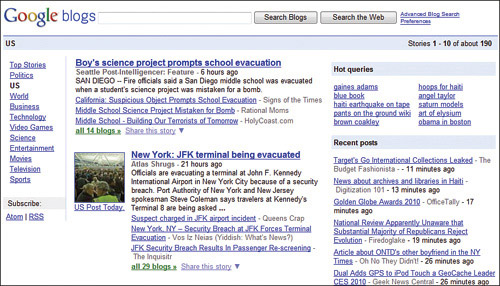
- Enter your query into the search box.
- Click the Search Blogs button.
Evaluating Blog Search Results
When you enter your blog search query, Google searches its index of RSS feeds and returns a page of blogs and blog postings that best match your query. As you can see in Figure 2.2, this page has two main parts.
Figure 2.2. The results of a query of Google Blog Search.
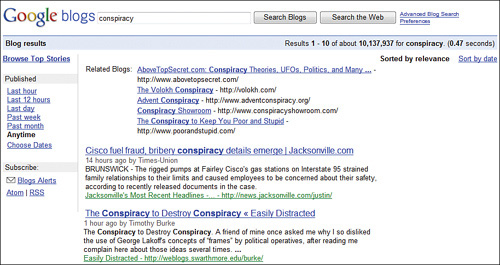
At the top of the page is a short listing of Related Blogs that have some relevance to your query. Click the blog name to view the entire blog.
Below that is a listing of individual blog posts. The title of the post is at the top of each listing; click the title to view the full posting. Below the title is a line that tells you when the posting was made, and who posted it. Then there’s the first few sentences of the post, serving as a summary. And, finally, there’s a link to the blog itself, listing both the blog’s title and URL; click the link to view the entire blog.
To view additional postings that match your query, scroll down to the bottom of the page and click the Next link or the Page Number link.
Fine-Tuning Your Query with Search Operators
Entering a Google Blog Search query is very similar to entering a standard Google web search query. Just enter one or more keywords into the search box, click the Search button, and you’re on your way.
In addition, you can apply advanced search operators to fine-tune your search results. You use these operators in conjunction with a normal keyword query in the search box, as detailed in Table 2.1.
Table 2.1. Google Blog Search Operators
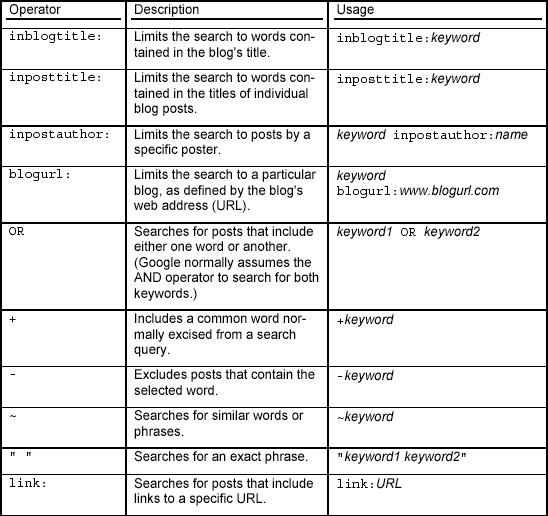
So, for example, if you wanted to find blogs that have the phrase “liberal politics” in their names, you would enter the following query:
inblogtitle:"liberal politics"
Using the Advanced Search Page
If you don’t like using search box operators, you can achieve the same results by using the Google Blog Search Advanced Blog Search page. You get to this page by clicking the Advanced Blog Search link on the main Google Blog Search page.
As you can see in Figure 2.3, the Advanced Blog Search page contains a number of search restrictions, all accessible by filling in the appropriate blanks or selecting items from a pull-down menu. Table 2.2 details the advanced search options available on this page.
Figure 2.3. Google Blog Search’s Advanced Blog Search page.
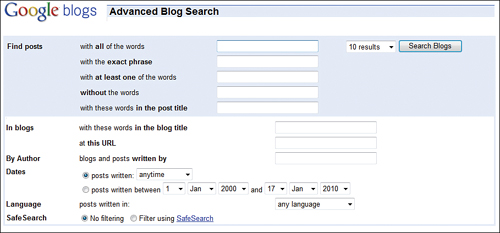
Table 2.2. Google Blog Search Advanced Blog Search Options
Subscribing to Blog Search Results
At the beginning of this section I talked a little about how Google gets its blog search results by using RSS feeds. Well, Google uses this same technology to feed you updates to the postings you find on the search results page. That’s right—Google syndicates its blog search results via RSS and Atom.
When you subscribe to an RSS or Atom search results feed, Google automatically notifies you of any new postings that match your search query. The notification can occur via email or as a feed subscription in Google Reader or other feed reader application. As new search results are found, either you’re notified or they show up as new postings within the feed.
 LET ME TRY IT
LET ME TRY IT
Subscribing to Search Results
To subscribe to a feed of search results, follow these steps:
- From the Google Blog Search page, conduct your blog search as normal.
- When the search results page appears, go to the Subscribe section in the left pane, shown in Figure 2.4, and click the link for the type of notification you want—Blogs Alerts (email), Atom feed, or RSS feed.
Figure 2.4. Subscribing to a search results feed.

Reading—and Commenting On—Blog Posts
Once you’ve found a blog you like, you now have to navigate that blog. Fortunately, most blogs are organized in a similar fashion—which is different from how most web pages are structured.
Show Me: Media 2.3—How to Navigate a Blog

To learn more about navigating blogs, see the video titled “How to Navigate a Blog” on the companion Using website, my.safaribooksonline.com/9780132119603/media.
Reading a Blog
Instead of the standard home page plus subsidiary page structure found on the Web, a blog typically has just a single page of entries, like the one shown in Figure 2.5. This main page contains the most recent blog posts, and might require a bit of scrolling to get to the bottom. There’s no introductory or home page; this main page serves as both introduction and primary content.
Figure 2.5. A typical blog page—newest posts appear at the top.
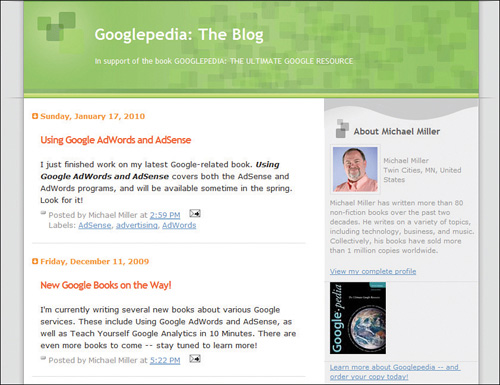
The blog posts themselves are arranged in reverse chronological order. That means that the most recent post is always at the top of the page, with older posts below that.
Reading a blog post is as simple as scrolling to that post and then reading it. There’s nothing fancy here, other than the occasional link to another blog or web page within the post. Just scroll and read.
That said, long posts on some blogs are sometimes divided in two, in order to keep from going too long on the main page. If you see a Read More link, like the one shown in Figure 2.6, click that link to go to a new page that contains the entire (long) blog post. Click your browser’s back button to return to the main blog post.
Figure 2.6. A Read More link to the rest of a long blog post.
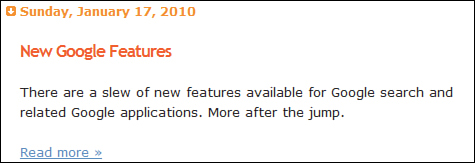
Viewing Older Posts
A main blog page contains only a limited number of posts—typically a dozen or fewer. Where, then, are those older posts that scroll off the main page?
Older posts are typically stored in the blog archives. You’ll normally find a link to the archives in the sidebar to the left or right of the main posts, like the one shown in Figure 2.7. There might be one huge archive, or individual archives organized by month. Click an archive link to view all posts for the selected time period.
Figure 2.7. A blog archive, with links to older posts.
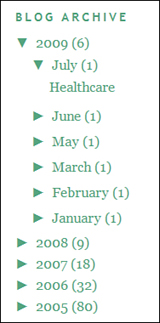
Commenting on Posts
Most bloggers let readers comment on their posts. That means if you find a post that interests you—and if you feel you can contribute to the discussion—you can click a link to add your comments.
This Comments link is typically located beneath the blog post, as shown in Figure 2.8. Click this link to see that post’s Comments page. As you can see in Figure 2.9, this page includes all existing comments on the selected post, as well as a box where you can enter your comments.
Figure 2.8. Click the Comments link to comment on a blog post—or read existing comments.

Figure 2.9. A blog Comments page.
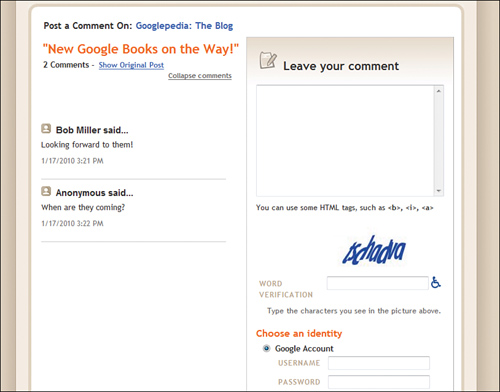
Show Me: Media 2.4—How to Post a Comment

To learn more about posting comments to a blog, see the video titled “How to Post a Comment” on the companion Using website, my.safaribooksonline.com/9780132119603/media.
Commenting on a Blog Post
To comment on a blog post, follow these steps:
- Click the Comments link below the blog post.
- When the Comments page appears, enter your comments into the Leave Your Comment box.
- If prompted, enter the secret word into the word verification box.
- If you have a Google account, enter your username (email address) and password into the appropriate blanks.
- If you don’t have a Google account, select the Name/URL option and enter your name or nickname and, if you like, the URL of your own blog or website.
- Alternately, you can opt to post without giving your name; click the Anonymous option.
- Click the Publish Your Comment button.
Your comment is now added to the bottom of the list of comments for this post.
Sharing a Blog Post
If you find a blog post you really like, you might want to share it with friends and colleagues. To that end, you can easily email a link to a post to your friends. It’s all a matter of filling out a short form.
 LET ME TRY IT
LET ME TRY IT
Emailing a Post
To email a blog post to a friend or colleague, follow these steps:
- Click the email icon below the post, as shown in Figure 2.10.
Figure 2.10. Click the email icon to share the blog post.
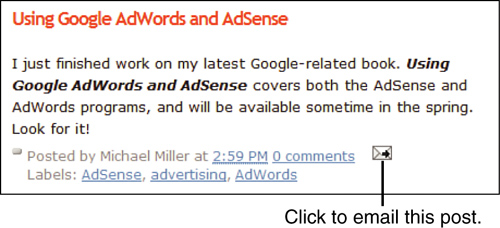
- When the Email Post to a Friend page appears, as shown in Figure 2.11, enter your name into the Your Name field.
Figure 2.11. Emailing a blog post to a friend.
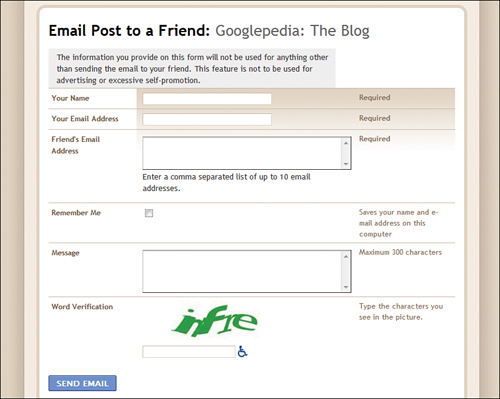
- Enter your email address into the Your Email Address field.
- Enter your friend’s email address into the Friend’s Email Address field. You can enter up to ten email addresses, separated by commas.
- If you want Blogger to remember your name and email address, check the Remember Me option.
- Enter a short message to accompany this email into the Message blank.
- Enter the secret word into the Word Verification box.
- Click Send Email.
Your friend now receives an email with a link to this blog post, like the one shown in Figure 2.12. When she clicks the link in the email, the blog post opens in her web browser.
Figure 2.12. Your friend receives an email message with a link to the blog post.
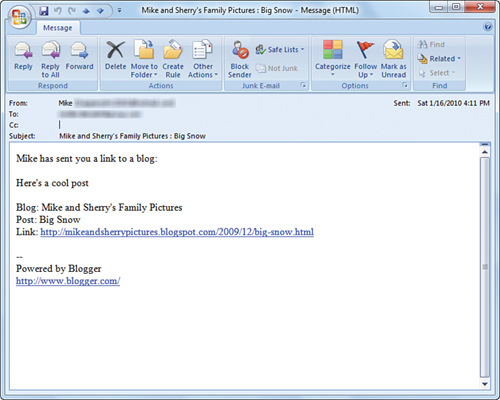
Subscribing to Your Favorite Blogs
Many blogs let you subscribe to a feed of their posts. This is an updated list of all new posts; a feed subscription uses RSS or Atom technology to notify you of all new posts made to that blog.
You typically subscribe to a blog’s feed directly from the blog. How you do this depends on the configuration for that particular blog.
 LET ME TRY IT
LET ME TRY IT
Subscribing to a Basic Atom Feed
By default, Blogger will display a link to a blog’s feed at the bottom of the blog page. Follow these steps to subscribe to the blog:
- Scroll to the bottom of the blog page and click the Subscribe to: Posts (Atom) link, like the one shown in Figure 2.13.
Figure 2.13. The link to a standard Blogger Atom feed.

- When the feed page appears, copy the URL for this page.
- Paste the URL for the feed into your feed reader program.
Blogger also lets its authors use the FeedBurner service to provide advanced feed capabilities. Blogs that use the FeedBurner service typically have a Subscribe To gadget in their sidebars, like the one shown in Figure 2.14.
Figure 2.14. A Subscribe To gadget.
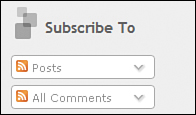
 LET ME TRY IT
LET ME TRY IT
Subscribing to a FeedBurner Feed
To subscribe to this type of blog, follow these steps:
- Go to the Subscribe To gadget and click the Posts button.
- This displays a list of available feed readers, as shown in Figure 2.15: Google Reader, Bloglines, Netvibes, NewsGator, and My Yahoo!. If you use one of these feed readers, click the appropriate button.
Figure 2.15. Choosing from available feed readers.

- If you use another feed reader, click the Atom link. When the next page appears, as shown in Figure 2.16, select a feed reader from the Choose Your Reader list.
Figure 2.16. A blog’s FeedBurner page.
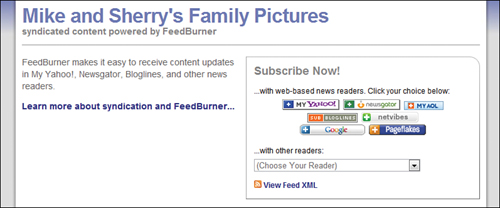
Choosing a Feed Reader
How do you view the blogs you’ve subscribed to? By using an application called a feed reader—a software program or website that monitors and displays all the blog feeds you’ve subscribed to.
The most popular feed reader applications include the following:
• Bloglines (www.bloglines.com)
• Feedreader (www.feedreader.com)
• NewsGator FeedDemon (www.feeddemon.com)
In addition, many personalized web start pages, including iGoogle (www.google.com/ig), My Yahoo! (http://my.yahoo.com), and Netvibes (www.netvibes.com), let you display blog feeds as gadgets or widgets on the page. If you use one of these start pages, that’s a good way to go.
And then there’s Google Reader (http://reader.google.com), Google’s very own feed reader application. This is a web-based reader that’s free for anyone to use.
Using Google Reader
Google Reader lets you read both blog feeds and news feeds. That means you can use Google Reader to display the latest news headlines from popular news sites, as well as catch the latest ponderings from your favorite bloggers. All you need to do is know which feed you want to subscribe to; Google Reader automatically displays the latest content, all in one place.
Show Me: Media 2.5—How to View Blog Feeds with Google Reader

To learn about using Google Reader to view blog feeds, see the video titled “How to View Blog Feeds with Google Reader” on the companion Using website, my.safaribooksonline.com/9780132119603/media.
As you can see in Figure 2.17, the blogs you’ve subscribed to are displayed in the left panel. To read the latest postings for a given blog, just click the blog name; the blog postings are displayed in the window on the right, as shown in Figure 2.18. Use the scrollbar or the Previous Item/Next Item buttons to move through the postings.
Figure 2.17. Reading blog feeds and news feeds with Google Reader.
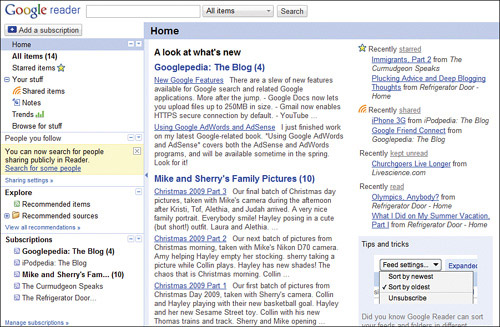
Figure 2.18. Reading posts for a selected blog.
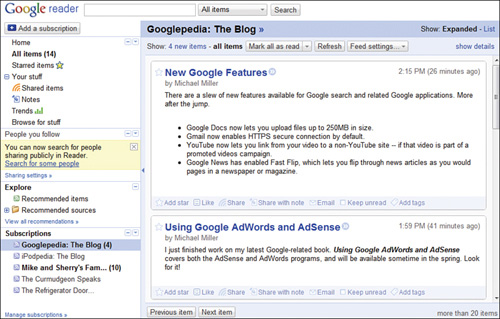
If you’d prefer to view only the titles of the blog postings, select the List View tab. This displays a list of postings; click any title to expand the listing and read the complete posting.
By the way, if you’d prefer to read a posting on the original blog site itself, rather than in Google Reader, click the title of the blog entry. The selected post on the original blog site opens in a new browser window.
